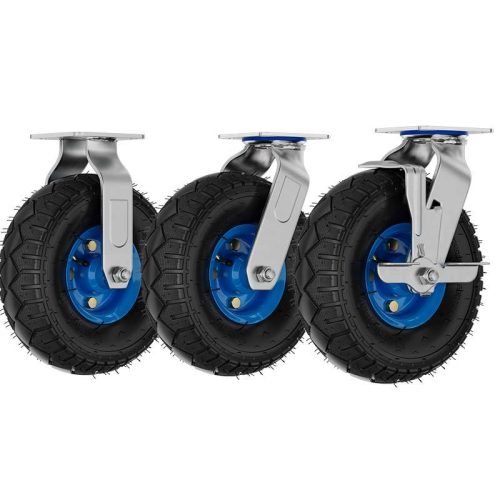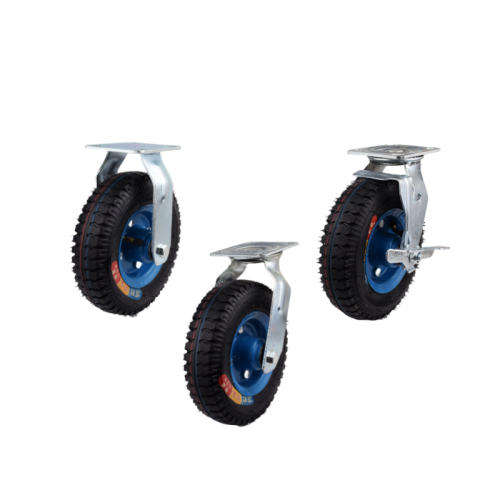When it comes to choosing the right wheel type for your material handling equipment, you have various options to consider. Pneumatic casters are just one of these choices, and they come with their own set of advantages and disadvantages. In this article, we’ll compare pneumatic casters to other common wheel types, providing a detailed look at the pros and cons of each.
1. Pneumatic Casters
Pros:
- Shock Absorption: Pneumatic casters excel at shock absorption, making them ideal for fragile or sensitive materials. They can cushion the impact of bumps and uneven surfaces, reducing the risk of damage.
- Smooth and Quiet Operation: Pneumatic casters offer a smooth and quiet ride. The air-filled tires create a cushioning effect that minimizes friction and noise, suitable for environments where noise reduction is essential.
- Improved Traction: Pneumatic casters provide excellent traction, particularly on rough terrains or uneven surfaces. They grip well, reducing the risk of slippage and enhancing safety.
Cons:
- Maintenance: Pneumatic casters require more maintenance due to their tires, which can be susceptible to punctures and leaks. Regular inflation checks are necessary.
- Load Capacity: They have a limited load capacity compared to some other wheel types. Heavy loads might require alternative caster options.
2. Solid Rubber Casters
Pros:
- Low Maintenance: Solid rubber casters are low maintenance and are not prone to punctures or leaks. They can handle rough surfaces without the risk of deflation.
- High Load Capacity: They offer a higher load capacity than pneumatic casters, making them suitable for heavy-duty applications.
- Durability: Solid rubber casters are durable and resistant to wear and tear, ensuring a longer lifespan.
Cons:
- Less Shock Absorption: Solid rubber casters do not provide the same level of shock absorption as pneumatic casters, making them less suitable for delicate materials.
- Less Traction: They may not provide the same level of traction on rough terrains or uneven surfaces.
3. Polyurethane Casters
Pros:
- Low Rolling Resistance: Polyurethane casters have low rolling resistance, which requires less effort to move loads. This can reduce operator fatigue.
- Durability: They are highly durable and can resist chemicals, abrasion, and wear.
- Versatility: Polyurethane casters are versatile and suitable for a wide range of applications, including both indoor and outdoor use.
Cons:
- Less Shock Absorption: They do not provide as much shock absorption as pneumatic casters, making them less suitable for fragile materials.
- Limited Traction: Polyurethane casters may not offer the same level of traction on rough surfaces as other wheel types.
4. Nylon Casters
Pros:
- High Load Capacity: Nylon casters can handle heavy loads with ease, making them suitable for industrial and manufacturing environments.
- Low Rolling Resistance: They offer low rolling resistance, reducing the effort required for pushing or pulling loads.
- Durability: Nylon casters are durable and resistant to wear, making them a long-lasting option.
Cons:
- Limited Shock Absorption: They have minimal shock absorption capabilities, making them less suitable for applications requiring vibration reduction.
- Limited Traction: Nylon casters may not provide adequate traction on slippery or uneven surfaces.
In conclusion, the choice between pneumatic casters and other wheel types depends on your specific application and requirements. Pneumatic casters excel in shock absorption, smooth operation, and traction but may require more maintenance and have a lower load capacity. Other wheel types like solid rubber, polyurethane, and nylon casters offer their own set of advantages and drawbacks, so consider your needs carefully when making your selection.


